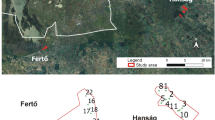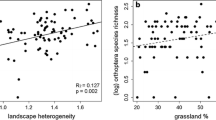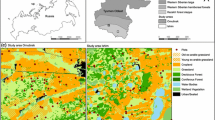Abstract
Calcareous grasslands represent local hotspots of biodiversity in large parts of Central and Northern Europe. They support a great number of rare species which are adapted to these xerothermic habitats. Due to massive changes in land use, calcareous grasslands have become a rare habitat type and their conservation has been given a high priority in the habitats directive of the European Union. It is well known that grassland management may affect biodiversity substantially. However, the quality of calcareous grasslands is also influenced by abiotic conditions, such as aspect (i.e. sun exposure), which affects the local mesoclimate. We studied the combined effects of aspect and grassland management on Orthoptera diversity on 16 sites in Central Germany, in an unbalanced crossed design with three factors: aspect, management type and management intensity. For both response variables (diversity and abundance) we obtained a similar pattern. South-facing pastures maintained a greater diversity than north-facing pastures, but both had a greater diversity than extensively used meadows. Intensively used meadows maintained the lowest diversity and abundances. A multivariate analysis revealed that the abundance of rare Orthoptera species correlated with bare ground cover and forb cover, both of which were greatest at south-facing pastures. Our results suggest that grazing is a more suitable management for maintaining a high biodiversity in calcareous grasslands than mowing. Moreover, the mesoclimate (in this studied measured by its surrogate: aspect) is a crucial factor determining species richness and needs to be considered in reserve planning.




Similar content being viewed by others
References
Adler PB, Raff DA, Lauenroth WK (2001) The effect of grazing on the spatial heterogeneity of vegetation. Oecologia 128:465–479
Atkinson PW, Fuller RJ, Vickery JA, Conway GJ, Tallowin JRB, Smith REN, Haysom KA, Ings TC, Asteraki EJ, Brown VK (2005) Influence of agricultural management, sward structure and food resources on grassland field use by birds in lowland England. J Appl Ecol 42:932–942
Bakker JP, Berendse F (1999) Constraints in the restoration of ecological diversity in grassland and heathland communities. Trends Ecol Evol 14:63–68
Batary P, Baldi A, Szel G, Podlussany A, Rozner I, Erdos S (2007) Responses of grassland specialist and generalist beetles to management and landscape complexity. Divers Distrib 13:196–202
Bazelet CS, Samways MJ (2011a) Identifying grasshopper bioindicators for habitat quality assessment of ecological networks. Ecol Indic 11:1259–1269
Bazelet CS, Samways MJ (2011b) Relative importance of management vs. design for implementation of large-scale ecological networks. Landscape Ecol 26:341–353
Branson DH, Sword GA (2010) An experimental analysis of grasshopper community responses to fire and livestock grazing in a northern mixed-grass prairie. Environ Entomol 39:1441–1446
Cocca G, Sturaro E, Gallo L, Ramanzin M (2012) Is the abandonment of traditional livestock farming systems the main driver of mountain landscape change in Alpine areas? Land Use Pol 29:878–886
Cousins SAO, Eriksson O (2002) The influence of management history and habitat on plant species richness in a rural hemiboreal landscape, Sweden. Landscape Ecol 17:517–529
DeBano SJ (2006) The effect of livestock grazing on the rainbow grasshopper: Population differences and ecological correlates. West North Am Naturalist 66:222–229
Fabriciusova V, Kanuch P, Kristin A (2011) Response of Orthoptera assemblages to management of montane grasslands in the Western Carpathians. Biologia 66:1127–1133
Fartmann T, Kramer B, Stelzner F, Poniatowski D (2012) Orthoptera as ecological indicators for succession in steppe grassland. Ecol Indic 20:337–344
Froehlich C (1994) Analyse der Habitatpräferenzen von Heuschreckenarten (Orthoptera: Saltatoria) in einem Mittelgebirgsraum unter Berücksichtigung regionaler Differenzierungen. Articulata Beiheft 4:1–176
Greatorexdavies JN, Sparks TH, Hall ML (1994) The response of heteroptera and coleoptera species to shade and aspect in rides of coniferised lowland woods in southern England. Biol Conserv 67:255–273
Grein G (2005) Rote Liste der in Niedersachsen und Bremen gefährdeten Heuschrecken mit Gesamtartenverzeichnis. Infdienst Natschutz Nieders 3. Fassung
Gröning J, Krause S, Hochkirch A (2007) Habitat preferences of an endangered insect species, Cepero’s ground-hopper (Tetrix ceperoi). Ecol Res 22:767–773
Guido M, Gianelle D (2001) Distribution patterns of four Orthoptera species in relation to microhabitat heterogeneity in an ecotonal area. Acta Oecol 22:175–185
Henle K, Amler K, Biedermann R, Kaule G, Poschlod P (1999) Bedeutung und Funktion von Arten und Lebensgemeinschaften in der Planung. In: Amler K, Bahl A, Henle K, Kaule G, Poschlod P, Settele J (eds) Populationsbiologie in der Naturschutzpraxis. Ulmer, Stuttgart, pp 17–23
Hjermann DO, Ims RA (1996) Landscape ecology of the wart-biter Decticus verrucivorus in a patchy landscape. J Anim Ecol 65:768–780
Hochkirch A, Adorf F (2007) Effects of prescribed burning and wildfires on Orthoptera in Central European peat bogs. Environ Conserv 34:225–235
Hochkirch A, Gröning J, Krause S (2007a) Intersexual niche segregation in Cepero’s Ground-hopper, Tetrix ceperoi. Evol Ecol 21:727–738
Hochkirch A, Witzenberger KA, Teerling A, Niemeyer F (2007b) Translocation of an endangered insect species, the field cricket (Gryllus campestris Linnaeus, 1758) in northern Germany. Biodivers Conserv 16:3597–3607
Hochkirch A, Gärtner AC, Brandt T (2008) Effects of forest-dune ecotone management on the endangered heath grasshopper, Chorthippus vagans (Orthoptera: Acrididae). Bull Entomol Res 98:449–456
Hunter ML (2005) A mesofilter conservation strategy to complement fine and coarse filters. Conserv Biol 19:1025–1029
Ingrisch S, Köhler G (1998a) Die Heuschrecken Mitteleuropas. Westarp Wissenschaften, Magdeburg
Ingrisch S, Köhler G (1998b) Rote Liste der Geradflügler (Orthoptera s.l.). In: Binot M, Bless R, Boye P, Gruttke H, Pretscher P (eds) Rote Liste gefährdeter Tiere Deutschlands. Schriftenreihe für Landschaftspflege und Naturschutz, vol 55. Bundesamt für Naturschutz, Bonn, pp 252–254
Jamison BE, Robel RJ, Pontius JS, Applegate RD (2002) Invertebrate biomass: associations with lesser prairie-chicken habitat use and sand sagebrush density in southwestern Kansas. Wildl Soc Bull 30:517–526
Joern A (2004) Variation in grasshopper (Acrididae) densities in response to fire frequency and bison grazing in tallgrass prairie. Environ Entomol 33:1617–1625
Kok OB, Louw SV (2000) Avian and mammalian predators of Orthoptera in semi-arid regions of South Africa. S Afr J Wildl Res 30:122–128
Luoto M (2000) Modelling of rare plant species richness by landscape variables in an agriculture area in Finland. Plant Ecol 149:157–168
Maas S, Detzel P, Staudt A (2002) Gefährdungsanalyse der Heuschrecken Deutschlands. Bundesamt für Naturschutz, Bonn
Morris MG (2000) The effects of structure and its dynamics on the ecology and conservation of arthropods in British grasslands. Biol Conserv 95:129–142
Muller S, Dutoit T, Alard D, Grevilliot F (1998) Restoration and rehabilitation of species-rich grassland ecosystems in France: a review. Restor Ecol 6:94–101
Odum EP, Connell CE, Davenport LB (1962) Population energy-flow of 3 primary consumer components of old-field ecosystems. Ecology 43:88
Oksanen J, Kindt R, Legendre P, O’Hara B, Stevens MHH (2007) Vegan: community ecology package
Olff H, Ritchie ME (1998) Effects of herbivores on grassland plant diversity. Trends Ecol Evol 13:261–265
O’Neill KM, Olson BE, Rolston MG, Wallander R, Larson DP, Seibert CE (2003) Effects of livestock grazing on rangeland grasshopper (Orthoptera: Acrididae) abundance. Agr Ecosyst Environ 97:51–64
Oschmann M (1973) Untersuchungen zur Biotopbindung der Orthopteren. Trans Entomol Soc Lond 4:177–296
Parsons AJ, Dumont B (2003) Spatial heterogeneity and grazing processes. Anim Res 52:161–179
Poschlod P, WallisDeVries MF (2002) The historical and socioeconomic perspective of calcareous grasslands—lessons from the distant and recent past. Biol Conserv 104:361–376
Proulx M, Mazumder A (1998) Reversal of grazing impact on plant species richness in nutrient-poor vs. nutrient-rich ecosystems. Ecology 79:2581–2592
Pywell RF, Bullock JM, Hopkins A, Walker KJ, Sparks TH, Burke MJW, Peel S (2002) Restoration of species-rich grassland on arable land: assessing the limiting processes using a multi-site experiment. J Appl Ecol 39:294–309
Steffan-Dewenter I, Tscharntke T (2002) Insect communities and biotic interactions on fragmented calcareous grasslands—a mini review. Biol Conserv 104:275–284
Stoner KJL, Joern A (2004) Landscape vs. local habitat scale influences to insect communities from tallgrass prairie remnants. Ecol Appl 14:1306–1320
Swengel AB (2001) A literature review of insect responses to fire, compared to other conservation managements of open habitat. Biodivers Conserv 10:1141–1169
R Development Core Team (2012) R: A language and environment for statistical computing. Vienna
Uvarov BP (1931) Insects and climate. Trans Entomol Soc Lond 79:1–232
Uvarov BP (1977) Grasshoppers and locusts: a handbook of general acridology, vol 2. Cambridge University Press, Cambridge
Vadkerti E, Szozvenyi G (2005) Habitat preference of four protected bush-cricket species (Orthoptera, Phaneropteridae, Isophya) in South Hungary. Biologia 60:545–549
van Teeffelen AJA, Cabeza M, Poyry J, Raatikainen K, Kuussaari M (2008) Maximizing conservation benefit for grassland species with contrasting management requirements. J Appl Ecol 45:1401–1409
Venables WN, Ripley BD (2002) Modern applied statistics with S. Springer, New York
Welch JL, Redak R, Kondratieff BC (1991) Effect of cattle grazing on the density and species of grasshoppers (Orthoptera, Acrididae) of the Central Plains Experimental Range, Colorado—a reassessment after 2 decades. J Kans Entomol Soc 64:337–343
Wellstein C, Otte A, Waldhardt R (2007) Impact of site and management on the diversity of central European mesic grassland. Agr Ecosyst Environ 122:203–210
Weyer J, Weinberger J, Hochkirch A (2012) Mobility and microhabitat utilization in a flightless wetland grasshopper, Chorthippus montanus (Charpentier, 1825). J Insect Conserv 16:379–390
Willerding C, Poschlod P (2002) Does seed dispersal by sheep affect the population genetic structure of the calcareous grassland species Bromus erectus? Biol Conserv 104:329–337
Acknowledgments
We are grateful to Bertram Preuschhof (conservation administration Göttingen) for providing information to the study sites.
Author information
Authors and Affiliations
Corresponding author
Rights and permissions
About this article
Cite this article
Weiss, N., Zucchi, H. & Hochkirch, A. The effects of grassland management and aspect on Orthoptera diversity and abundance: site conditions are as important as management. Biodivers Conserv 22, 2167–2178 (2013). https://doi.org/10.1007/s10531-012-0398-8
Received:
Accepted:
Published:
Issue Date:
DOI: https://doi.org/10.1007/s10531-012-0398-8




